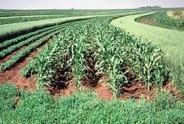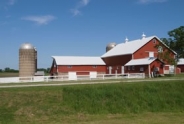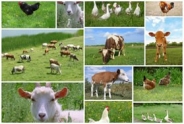Fertilizer Calculations
Katelyn Miller, Field Crops and Forage Specialist
Southwest New York Dairy, Livestock and Field Crops Program

In last month's newsletter, we discussed how to interpret soil test results from Dairy One's lab, along with a brief overview of how to calculate fertilizer requirements based on those results. However, two things became clear:
- There are many different formulas for calculating fertilizer needs, and the right formula depends on the situation.
- A refresher on how to calculate fertilizer applications would be useful for many of us.
So, this month's article is packed with math (yes, you read that right), to help walk you through the calculations needed to determine the right fertilizer applications for your farm. We'll cover everything from understanding fertilizer labels to calculating how much of each fertilizer to apply based on your soil test results.
Fertilizer products are labeled with three numbers in the format N-P2O5-K2O (or N-P-K). These numbers represent the weight percentages of Nitrogen (N), Phosphorus (P2O5), and Potassium (K2O) in the fertilizer. For example, a fertilizer labeled 15-10-10 contains:
- 15% Nitrogen (N)
- 10% Phosphorus (P2O5)
- 10% Potassium (K2O)
The purpose of this labeling system is to help farmers understand the nutrient composition of the fertilizer so they can calculate how much of each nutrient is present in the product.
Example 1: Calculating Pounds of Nutrients in a Bag
Let's say you have a 50-pound bag of fertilizer labeled 15-10-10. You want to calculate how many pounds of nitrogen (N), phosphorus (P2O5), and potassium (K2O) are in the bag. Here's how to do it:
The general formula to calculate the pounds of nutrient is:
Pounds of Nutrient = Weight of Product ?-- (Percentage of Nutrient/100)
Now, let's break it down:
- Nitrogen (N): 50 lbs ?-- 0.15 = 7.5 lbs of nitrogen
- Phosphorus (P2O5): 50 lbs ?-- 0.10 = 5 lbs of phosphorus
- Potassium (K2O): 50 lbs ?-- 0.10 = 5 lbs of potassium
So, in a 50-pound bag of 15-10-10 fertilizer, there are 7.5 lbs of nitrogen, 5 lbs of phosphorus, and 5 lbs of potassium.
Now that you understand how to calculate the nutrient content in a fertilizer, we can move on to calculating how much fertilizer you need to apply based on your soil test results.
Example 2: Meeting Potassium Needs with Muriate of Potash
Let's say your soil test shows you need to apply 80 pounds of K2O per acre. You're planning to use muriate of potash (0-0-60), which means the product contains 60% potassium (K2O).
To calculate how much muriate of potash is required, you can use the following ratio:
60 lbs K2O 80 lbs K2O
____________________ = ____________________
100 lbs fertilizer X lbs fertilizer
In this case, the unknown is X, or the amount of fertilizer you need to apply to meet the potassium requirement. To solve for X, we can cross-multiply and solve the equation:
60?--X=80?--100
60X=8,000
Now, divide both sides of the equation by 60 to solve for X:
X=8,000/60=133.33lbs of muriate of potash per acre
So, you would need to apply 133.33 lbs of muriate of potash per acre to meet the potassium requirement of 80 lbs K2O.
In many cases, you may need to blend different fertilizers to meet multiple nutrient needs for your crops. Let's say your soil test recommends applying 80 lbs of P2O5 and 95 lbs of K2O per acre. You have access to two fertilizers:
- 0-46-0 (for phosphorus, P2O5)
- 0-0-60 (for potassium, K2O)
Here's how we can calculate how much of each fertilizer you need to apply.
Phosphorus (P2O5) Requirement
First, we calculate how much 0-46-0 fertilizer is needed to meet the phosphorus requirement. Using the same formula as before:
46 lbs P2O5 80 lbs P2O5
____________________ = ____________________
100 lbs fertilizer X lbs fertilizer
Solving for X:
46X=80?--100
46X=8,000
X=8,000/46=173.9 lbs of 0-46-0 per acre
So, you need 173.9 lbs of 0-46-0 per acre to meet the phosphorus requirement.
Potassium (K2O) Requirement
Next, we calculate how much 0-0-60 fertilizer is needed to meet the potassium requirement. Using the formula:
60 lbs K2O 95 lbs K2O
____________________ = ____________________
100 lbs fertilizer X lbs fertilizer
Solving for X:
60X=95?--100
X=95?--100
X=9,500/60=158.3 lbs of 0-0-60 per acre
So, you need 158.3 lbs of 0-0-60 per acre to meet the potassium requirement.
Total Fertilizer Requirements
To meet the needs of both nutrients, the total amount of fertilizer needed for each nutrient is:
- 0-46-0: 173.9 lbs/acre ?-- 20 acres = 3,478 lbs
- 0-0-60: 158.3 lbs/acre ?-- 20 acres = 3,166 lbs
To calculate the final nutrient analysis of the blended fertilizer, we need to find the percentage of phosphorus and potassium in the final mix:
For phosphorus:
80 lbs of P2O5
_________________ x 100 =24% P2O5
173.9+158.3
For potassium:
95 lbs of K2O
__________________ x 100 =28% K2O
173.9+158.3
So, the final analysis of the blended fertilizer will be 0-24-28 (0% nitrogen, 24% phosphorus, and 28% potassium).
Liquid fertilizers are also common, and calculating their application rates is slightly different because they are measured by volume, not weight. Let's look at an example using a liquid fertilizer labeled 10-15-10, with a weight of 12 pounds per gallon and a tank size of 50 gallons.
Example 3: Nutrient Content in a 50-Gallon Tank
To find how many pounds of each nutrient are in the tank, we multiply the concentration of each nutrient by the weight of the product and the number of gallons:
- Nitrogen (N):
10 lbs N?--12 lbs/gal?--50 gal=60 lbs of N in the tank
- Phosphorus (P2O5):
15 lbs P2O5?--12 lbs/gal?--50 gal=90 lbs of P2O5 in the tank
- Potassium (K2O):
10 lbs K2O?--12 lbs/gal?--50 gal=60 lbs of K2O in the tank
Example 4: Gallons Needed to Apply Nitrogen
If you want to apply 50 pounds of nitrogen per acre, you can calculate how many gallons of this liquid fertilizer are needed using the following formula:
60 lbs N 50 gal
__________ = _____________
50 lbs N X gallons
Solving for X:
60X=50?--60
X=2,500/60=41.7 gallons per acre
Thus, to apply 50 lbs of nitrogen per acre, you would need to apply 41.7 gallons of fertilizer per acre.
By understanding how to read fertilizer labels and perform these calculations, you can ensure that your crops get the right amount of nutrients without over- or under-applying. Whether you're using granular or liquid fertilizers, knowing how to calculate nutrient requirements and fertilizer application rates is essential for optimal crop growth and cost-effective farming.
Upcoming Events
Memoir Reading: Barn Gothic
December 4, 2025
Bath, NY
Barn Gothic is an elegy for family farmers and an intimate portrait of three generations laboring to be fathers and sons while their livelihood falls apart. Beautifully told with a farmer's restraint and a poet's grace, it is a story of personal loss amid corporate corruption and of finding a way forward when everything you know disappears.
NY Small Farms Summit 2025: Stronger Together
December 5, 2025
Alfred, NY
We hope you will join us on December 5th for the 2025 New York Small Farms Summit! This is an opportunity to meet other farmers and ag supporters, learn about research and education projects, and set priorities for future efforts to grow small farm success.
At the Allegany County site, we will focus on giving trees a chance and how trees build resiliency on small farms. Whether attracted to fruit, nuts, vegetables, fodder or shade, trees can be an integral part of a successful farming system. Join us as we explore the opportunities for resiliency that come from adding tree crops or managing wooded areas of your farm for agroforestry or silvopasture systems.
Crops, Cows & Critters - Southwest New York Dairy, Livestock & Field Crops Newsletter Sponsorship
December 19, 2025
Our two forms of publications feature research-based and timely information from our four specialists, listed to the right, along with local event notifications and Cornell University outreach. This information is provided to participants who range from dairy, livestock, and field crops producers to agricultural suppliers and consultants.
Weekly Email Update: Shared with 625+ households who have signed up with our program.
Monthly Paper Mailer: To reach our stakeholders and farmers who lack internet access, we send out a monthly mailer where your company's logo and contact information would be featured with a mailing list of 330+ households.
If you sponsor our weekly and monthly publications you reach approximately 955 households.
Visit our website to view our newsletters!
Announcements
No announcements at this time.





